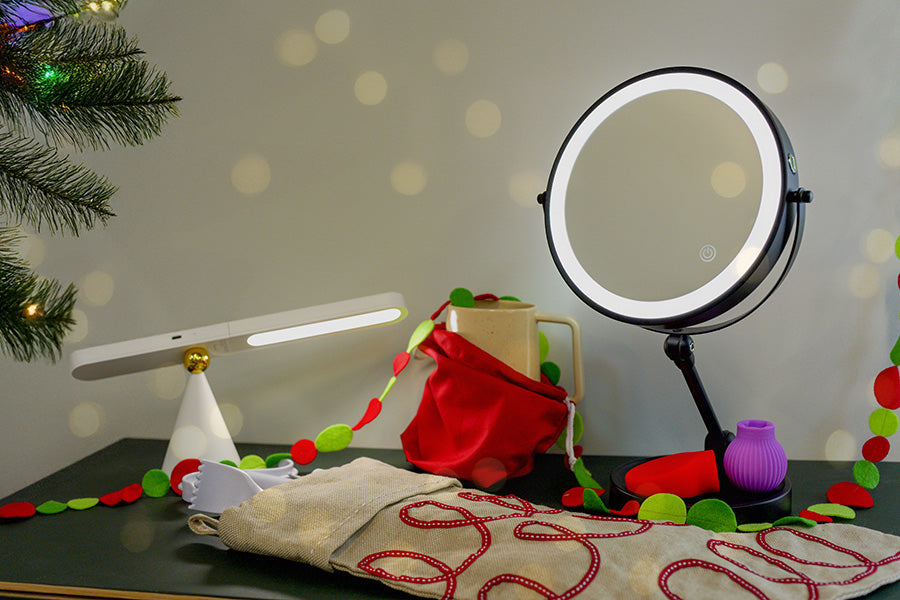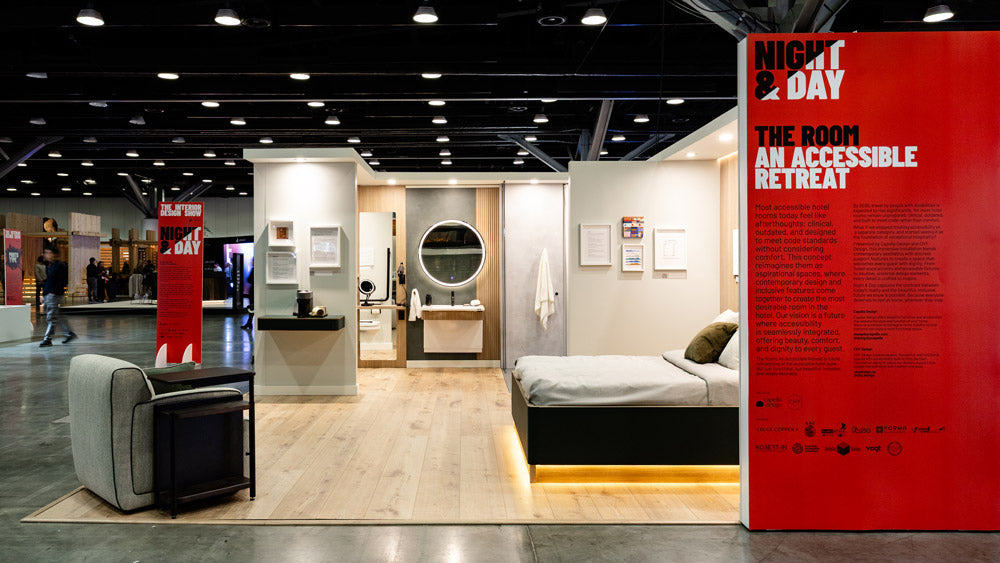Room-by-Room Guide to Grab Bars
Where to Place Them, Why They Matter, and How to Choose Ones That Actually Look Good
Grab Bars for the Home: Where to Begin
If you're thinking about adding grab bars to your home, you’re probably weighing a lot of questions and trying to make the right call for yourself or someone you love. Whether you're supporting a parent after a fall, preparing your home after surgery, or planning for the years ahead, it can be hard to know where to start.
Where should they go? What size do you need? What will they look like in your space? Do they all feel clinical?
Most resources focus on function (what meets code, what holds weight) but they rarely offer a clear path forward. And they almost never speak to how these choices feel.
At Capella, we know this process isn’t just technical. It’s personal. This guide is here to help you move forward with confidence.
We’ll walk through each major area of the home and help you identify where support matters most. Along the way, we’ll share ideas that combine thoughtful safety with lasting design, because support should never come at the cost of comfort, dignity, or style.
Why Grab Bars Matter (Even If No One’s Asking for Them Yet)

Most people don’t think about grab bars until they absolutely need them. By the time they come up in conversation, it’s often after a fall, a hospital visit, or a moment that changes how someone moves through their home.
And most people think of grab bars as something you reach for in an emergency - something to keep you from hitting the ground.
But in practice, they do much more. They steady you as you step into the shower. They offer support as you shift from sitting to standing. They give you something to hold when you’re tired, when the floor is wet, or when you just need a moment.
They bring comfort, not just caution.
Independence, not just safety.
And when they’re designed with intention, they fit into your home in a way that feels natural. They don’t just blend in, they enhance the space.
What starts as a simple addition can become one of the most relied-on features in the home.
What to Look For in a Good Grab Bar
Before we get into specific rooms, let’s cover the basics:
- Weight Capacity: Choose bars that support at least 250 lbs. Some options can hold up to 500 lbs.
- Permanent vs. Temporary: Permanent grab bars are the most reliable and safest option for home use. They provide long-term support and reduce the risk of accidents. Suction-cup models may be marketed for convenience but should never be used as a primary support.
- Installation: The safest bars mount directly into wall studs or use approved heavy-duty anchors.
- Form and Finish: Occupational Therapists recommend cylindrical grab bars with a diameter of approximately 1.25″ for optimal grip. Matte finishes offer better grip than glossy ones. Subtle texture adds safety and can even improve visual appeal.
- Integrated Options: Look for grab bars that double as towel holders, toilet paper holders, or art frames.
- Height and Placement: ADA guidance recommends a height between 33 and 36 inches from the floor to the bar, but some newer code suggests heights closer to 30 inches. For home use, feel free to experiment and adjust the placement to you or your family members’ natural reach and movement.
Bathroom Grab Bars: Addressing High-Risk, High-Use Areas

Why Support in This Room Matters
The bathroom is where we’re most vulnerable: Often barefoot, surrounded by slippery surfaces, and moving through tight spaces. Whether stepping over a tub edge, standing on one leg to dry off, or sitting down onto a low toilet, this room demands strength and balance from our bodies at a time when we may be tired, wet, or in a rush.
For caregivers, it’s often the first space where help is needed, and for older adults or people recovering from surgery, it’s where loss of confidence can start to show. That’s why thoughtful support here doesn’t just prevent falls. It builds comfort and reassurance into a daily routine.
Common Support Needs
- Stepping into or out of the tub or shower
- Standing safely while washing or rinsing
- Shifting from sitting to standing at the toilet
- Balancing while grooming at the sink
Where to Install Grab Bars In or Around the Shower or Tub:
- Long wall inside the shower: A horizontal bar 30–36 inches from the floor offers steadying support while standing or moving around.
- Rear wall: A shorter horizontal bar or vertical bar at the back of the shower supports turning, shifting weight, and repositioning under water.
- Control wall (faucets/shower head): A vertical bar near the controls helps with balance while adjusting water or stepping in. With the right hardware this can double as the slide bar for a detachable shower head.
- Shower entry or tub edge: A vertical bar just outside the enclosure supports safe entry and exit, especially when stepping over a threshold.
- Additional integrated/hidden options: A grab bar that surrounds the shower controls, a grab bar integrated into a soap or shampoo holder
Where to Install Grab Bars by the Toilet:
- Side wall (if available): An L-shaped bar about 30-36 inches from the floor. Toilet heights vary, but the bar should be just under 12 inches from the top of the toilet seat, with the vertical portion 6 inches away from the front of the toilet.
- Rear wall: A horizontal bar approximately 4 inches above the tank to match the height of the side wall bar.
- Fold-Down Bar: A grab bar that can fold out of the way, opposite the side wall bar. Mount at the same height as the side wall grab bar to increase support when standing up from the toilet.
- Integrated toilet paper holder + grab bar: Supports balance while offering daily function in a single fixture.
Where to Install Grab Bars by the Sink (if needed):
- A small vertical or horizontal bar beside a pedestal or wall-mounted sink where no counter exists, especially if the user leans or balances while grooming.
Capella Recommends
- Grab bars that double as towel holders
- Toilet paper holders with built-in support
- Style-matched finishes in matte black, brushed nickel, or bronze
- The Lotic Shower Seat, for added comfort in combination with bars
Alternatives
- Toilet safety frames or raised toilet seats (if wall-mounted bars aren't feasible)
- Weighted or wall-mounted shower chairs used in conjunction with mounted support
Avoid
- Relying on suction bars for weight-bearing support
- Using decorative towel bars as grab bars
- Installing into drywall without proper anchors or mounting to studs
Entryways and Mudrooms: The Overlooked Transition Zone

Why Support in This Room Matters
The front door is where we begin and end our day. It’s also where we juggle keys, groceries, bags, mobility aids, and uneven thresholds. Add in wet shoes, weather, or a pet underfoot, and a simple step inside can become risky fast.
Many people don’t think about installing a grab bar here, but it’s often one of the first places where a little support goes a long way. For older adults who want to continue welcoming guests or simply retrieve the mail with ease, the entryway becomes a place where design and dignity truly meet.
Common Support Needs
- Stepping over thresholds or uneven entry steps
- Removing or putting on shoes
- Holding steady while opening doors
Where to Install:
- Beside the doorframe inside: A vertical grab bar near the main entrance
- Outside the door: Especially helpful near stairs or on a porch
- By the mudroom bench: A support bar for balance while seated or standing
Capella Recommends
- The Selora Grab Bar Frame, which hides in plain sight behind artwork or a mirror
- Slim vertical bars matched to your trim, siding, or wall finish
- Muted tones or solid wood finishes like maple, walnut, or matte white
Alternatives
- A secured bench or console for seated support
- Anchored outdoor railings for steps
Avoid
- Leaning on storm doors or door frames
- Using lightweight or freestanding furniture for balance
- Unsecured entry mats
Bedroom Grab Bars: For Quiet Moments That Need Support

Why Support in This Room Matters
Getting out of bed in the morning or settling in for the night might seem simple—until it’s not. In the bedroom, lighting is softer, balance may be unsteady, and fatigue plays a big role. Whether it’s standing from bed, pulling on socks, or navigating a midnight bathroom trip, this space quietly asks our bodies to do a lot.
For anyone recovering from surgery or living with long-term mobility changes, the bedroom is where comfort should never come second to safety. Small additions like a vertical bar or secure bedside table can restore a sense of independence that starts and ends the day on your own terms.
Common Support Needs
- Standing up from bed
- Pulling up from a chair or vanity
- Navigating nighttime bathroom trips
Where to Install:
- Next to the bed: A vertical wall bar or assist pole
- By a dressing chair or mirror: A slim bar for balance
- Along the hallway to the bathroom: Especially if lighting is dim
Capella Recommends
- Compact wall bars in warm finishes that match your furniture
- Secure floor-to-ceiling poles for full-body support
- Pairing your support with our Corbel Side Table, which adds a surface for essentials and can be pushed out of the way when standing up from bed
Alternatives
- Securely mounted bed rails
- Anchored dressers for light assistance
Avoid
- Relying on nightstands, headboards, or smaller accessories for balance
- Freestanding poles without proper installation
- Cluttered floor areas or poorly lit walkways
Kitchen Grab Bars: Support in the Heart of the Home

Why Support in This Room Matters
The kitchen is often the heart of the home where we cook, connect, and move. It’s also where we’re constantly reaching, turning, standing, and carrying. But even in well-designed kitchens, fatigue, arthritis, or balance issues can turn once-simple tasks into hazards.
Unlike bathrooms or hallways, kitchens aren’t built with support in mind. That makes smart, subtle additions (like a low-profile bar near the sink or a supportive edge on the island) a powerful way to stay engaged in the rhythms of everyday life. Because preparing a favorite meal or making your morning coffee should still feel joyful, not risky.
Common Support Needs
- Holding balance while cooking or washing dishes
- Reaching high shelves or bending for drawers
- Navigating between sink, stove, and counter
Where to Install:
- Near sink or stove: A vertical bar helps with long standing periods
- On side walls: Slim bars placed between zones offer extra security
Capella Recommends
- Low-profile wall bars in finishes that match your cabinetry
- Subtle rounded bars that tuck into corners or paneling
- Brushed bronze, matte black, or white for a timeless look
Alternatives
- Anchored kitchen islands or counters
- Stable stools for semi-seated tasks
Avoid
- Using chairs, appliances, or mobile carts for support
- Installing bars near burners or ovens
Putting It All Together
This guide was created to answer the real questions people face when trying to make their homes safer: Where do grab bars go? What kind should I choose? How do I make sure they don’t look clinical?
We hope this room-by-room breakdown brings clarity. Not just about placement and safety, but about what’s possible when you expect more from accessible design. Grab bars shouldn’t be an afterthought. They should feel intentional. Integrated. Supportive in every sense of the word.
At Capella, we believe good design includes everyone. And support should never come at the expense of comfort, style, or identity.
Whether you’re new to the Capella Design community or not, we thought folks could use an update on what we’ve been up to this year. And was it ever a lot! From joining the permanent collection of a museum to winning a design award, here’s what you need to know about how Capella Design is creating distinction in the design-forward mobility product category.
- Incorporating premade food, whether that means ordering out or store bought sides and desserts
- Opting for gift bags over wrapping paper
- Sending calls or texts instead of holiday cards
- Saying no to gatherings causing caregiving strain (or that you just aren’t excited to attend!)
Put Yourself First
Prioritize your well-being this holiday season by scheduling regular self-care activities—whether that is a long walk, your favorite treat, or some uninterrupted time alone. As the saying goes, “put your oxygen mask on first before assisting others.”Remember that taking care of yourself is not selfish; it's an essential part of being an effective caregiver, so carve out time for activities that bring you joy and relaxation.
Let Your Home Help You Out
Organizing and preparing the home for a more accessible holiday season will create an environment that is both festive and conducive to caregiving responsibilities.Check out our post with tips on how to make your home more accessible for the holidays. These small changes can help you ensure a safe and comfortable space for you and your loved ones, alleviating a significant factor in caregiving stress.


Get customer attention by clean visual and video
Make it easy to buy by eliminating stumbling blocks to purchase. Don’t assume customers know which item you’re talking about in your post. Provide a link directly to the product page or just link the product to your blog so they can buy if they want. If it relevant give readers more than one way to get to the product.
Article credit: Heidi Cohen



